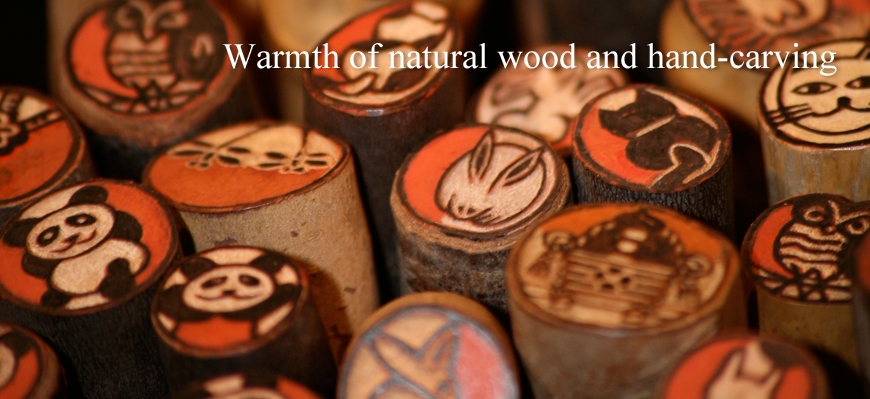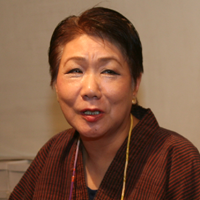
Mutsuko Ito
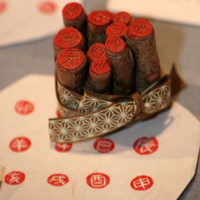
Seals carved with the twelve signs of the Chinese zodiac
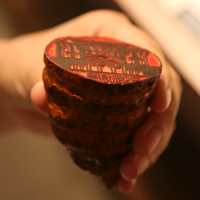
The largest seal in the form of a bamboo shoot
What is a seal?
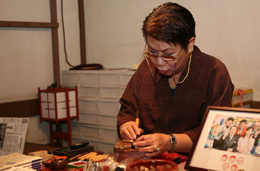
Mutsuko Ito, a seal carver, contrived artistic seals made of natural wood in 2000, and obtained a utility model patent. Illustrations by Ito are drawn on the seals, and customers' names are also carved on them. The seals are made of cherry trees, Japanese pepper trees, camellias, bamboo, flowering dogwoods, pomegranate trees or Japanese witch hazels.
What is the charm of a artistic seal made of natural wood?
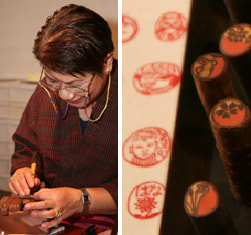
First of all, its hardness and shape differ according to types of wood, and, more importantly, grains are entirely different form one tree to another. After all, wood fits comfortably, especially, in human hands. It gradually gets a polish, and its quality is enhanced. An artistic seal is an original one in the world. Seals that have the exactly same shape and pattern cannot be created because they are handmade. The materials are hard, so I have some difficulties carving it. But it is more enjoyable than just carving charcters. Sizes of standard seals are limited because nowadays they are carved by machines. It is meaningless to carve artistic seals by machines because all the seals would have a same shape.
How did Ito become a seal carver?
Was your father also a seal carver?
Yes. He was a common seal carver in a town. He carved seals from boxwood, ivory and buffalo horns. But he fell sick just 3 or 4 years after I took over his job. It is called cerebral infarction, isn't it? The right side of his body was paralyzed, and he became unable to do any job. So I I studied carving almost completely on my own. It is the reason I can make these unique seals (artistic seals). If I have made ordinary seals, I could not get out of a common seal carver.
Seals
When did you hit upon the idea of making seals from small branches?
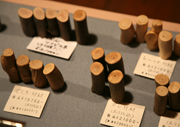
Could you tell me how to make a seal?
I put down a polishing material (glass or other materials), rub a seal material on it and flatten the surface. The center of the surface may have a dent even if it seems flat when the material is just cut out. When the surface is flattened, I apply vermilion ink on it. Then, I write characters or draw pictures on it using sumi ink, and carve it leaving black parts. These are the process of making seals.
How deep do you engrave the surface?
If I engrave it to a depth of 1 millimeter, it is too deep. I do not engrave to such extent. These are half-finished works. I clean up seals after carving names, so I do not engrave so deeply.
How long does it take to complete a seal?
It takes long time to think of designs. Once a design is determined, I can complete a seal in just 2 or 3 hours. I can also carve a name within one hour.
Tools
Could you tell me about engraving knives?
You are talking about tools that are used to engrave common seals made of ivory or buffalo horns, aren't you? I am using 12 or 13 types of knives. Widths of the edges vary. In addition, engraving knives have edges on its back. Today's seal carvers do not use these tools. They are using machines.
How do you care engraving knives?
I sharpen knives approximately once in a week. I carve hard materials, so if I do not sharpen knives, they become dull. I wind rattan around handles by myself. When blades are worn away and rattan is damaged, I pull edges out a few centimeters, rewind rattan around handles and sharpen edges. It is not easy because nowadays there are not so many craftsmen who can make engraving knives.
Could you tell me about the stand that holds seals?
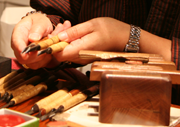
Ito's works
What is the most popular design nowadays?
Generally, it is the "Rabbit" that is the following year's Oriental zodiac sign. Also, customers' Oriental zodiac signs are popular. But when it is the year of the Snake, seals do not sell well. Seals carved with a design of "Jizo," or guardian deity of travelers and children, also sell well. Customers say they feel comforted. A design of cats is also popular.
Why do customers buy those seals?
They usually buy the seals as presents, such as a baby, wedding or Christmas present. Also, there was a man who gave the seal to a woman in return for the chocolate he received on Valentine's Day. A customer once asked me to carve a name on a seal with a cat design because his girlfriend likes cats. I also get overseas orders. Those international customers buy seals as presents, so I often carve their names on seals. Foreigners like the texture of wood. For example, cherry trees are popular. A while ago, American and French people joined my hands-on class, and enjoyed making seals on which Chinese characters representing letters of their names were carved. Many customers visit the hands-on class.

Mutsuko Ito

Seals carved with the twelve signs of the Chinese zodiac

The largest seal in the form of a bamboo shoot
What is a seal?

A seal is made of wood, ivory or stone, on which characters or pictographs are carved, and serves as proof or certification when pressed on a vessel, utensil, painting, document or letter. Its origin can be traced back to the ancient Mesopotamian civilization in 4,000 B.C. Later, it was introduced into China, and significantly developed during the the Han Dynasty. It was brought to Japan along with a variety of Chinese cultures through Japanese envoys in the Asuka Period.
Mutsuko Ito, a seal carver, contrived artistic seals made of natural wood in 2000, and obtained a utility model patent. Illustrations by Ito are drawn on the seals, and customers' names are also carved on them. The seals are made of cherry trees, Japanese pepper trees, camellias, bamboo, flowering dogwoods, pomegranate trees or Japanese witch hazels.
What is the charm of a artistic seal made of natural wood?

First of all, its hardness and shape differ according to types of wood, and, more importantly, grains are entirely different form one tree to another. After all, wood fits comfortably, especially, in human hands. It gradually gets a polish, and its quality is enhanced. An artistic seal is an original one in the world. Seals that have the exactly same shape and pattern cannot be created because they are handmade. The materials are hard, so I have some difficulties carving it. But it is more enjoyable than just carving charcters. Sizes of standard seals are limited because nowadays they are carved by machines. It is meaningless to carve artistic seals by machines because all the seals would have a same shape.






